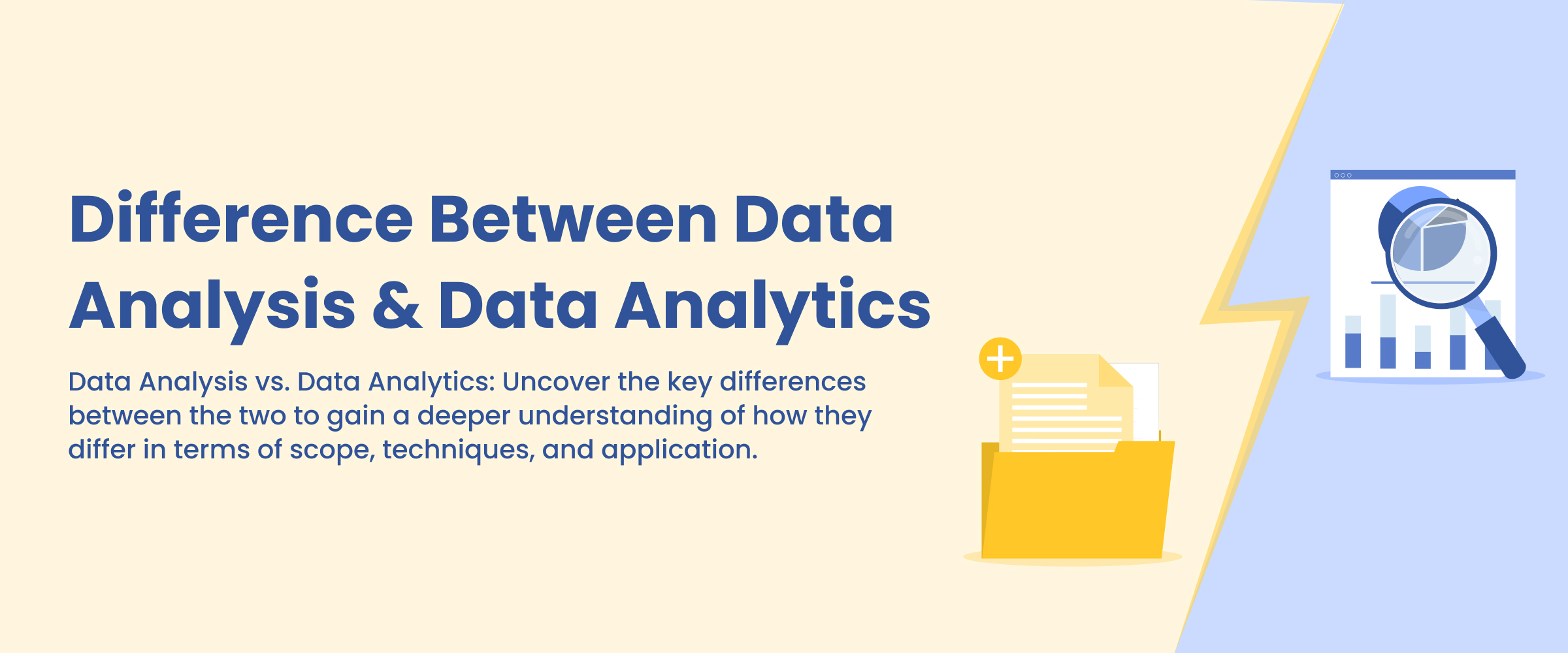Difference Between Data Analysis and Data Analytics
Data analysis and data analytics are two closely related terms. Data analysis refers to the process of examining datasets to draw conclusions or make predictions based on historical information. On the other hand, data analytics involves not only analyzing past trends but also utilizing advanced tools and techniques, such as machine learning algorithms and statistical models for predictive modeling and decision-making purposes. In this blog, we will explore the difference between data analysis and data analytics.
What is Data Analysis?
Data analysis refers to the examination, refinement, and organization of data to uncover meaningful insights and facilitate decision-making. This involves utilizing various methods and approaches to understand patterns, correlations, and connections within a dataset. It plays a significant role in different industries, such as business, science, healthcare, and finance, by providing valuable information for predictions. To become a pro in this field and land a promising career, consider taking an online data analyst course with a placement guarantee.
What is Data Analytics?
Data analytics is the method of analyzing extensive collections of information to identify significant patterns, tendencies, connections, and other valuable findings. This involves using a variety of methods and instruments to extract meaning from data, which can be applied to making informed decisions and predictions. Businesses across all sectors rely on data analytics to enhance their operations, streamline processes, improve customer satisfaction levels, and foster innovation.
Difference Between Data Analysis and Data Analytics
Below is a tabular representation of the difference between data analytics vs data analysis.
| Parameters | Data Analysis | Data Analytics |
| Scope | It is typically concerned with a specific dataset or a subset of data relevant to the problem at hand. | It often involves working with multiple, disparate data sources and integrating them for a comprehensive view. |
| Focus | It focuses on examining and interpreting data to answer specific questions or solve well-defined problems. | It takes a broader approach, aiming to discover insights, patterns, and trends from large datasets for decision-making and strategic planning. |
| Purpose | It is primarily used to understand and explain what happened in the past or what is currently happening. | It is more forward-looking, using historical data to predict future trends, behaviors, or outcomes. |
| Techniques | It relies heavily on statistical techniques, such as hypothesis testing, regression analysis, and data visualization. | It incorporates a wider range of techniques, including machine learning, predictive modeling, data mining, and big data processing. |
| Skill Set | It requires strong knowledge of statistical methods, data management, and domain expertise. | It demands skills in programming, machine learning, data mining, and familiarity with various data processing frameworks and architectures. |
| Output | It typically results in reports, dashboards, or presentations that communicate findings and insights. | It generates predictive models, forecasts, recommendations, or actionable insights that can inform business strategies and decision-making. |
| Tools | It typically employs tools like spreadsheets, statistical software (e.g., R, SAS, SPSS), and data visualization tools. | It often involves more advanced tools and technologies, such as Hadoop, Spark, Python, and specialized analytics platforms. |
Similarities Between Data Analysis and Data Analytics
While data analysis and data analytics are distinct disciplines, they share several similarities. Here are some of their similarities:
1. Data-Driven Approach: Both data analysis and data analytics rely on a data-driven approach to gain insights and make informed decisions. They involve working with data from various sources, including databases, spreadsheets, logs, and other data repositories.
2. Data Preprocessing: Both data analytics vs data analysis require data preprocessing steps, such as data cleaning, data transformation, and data integration. Techniques like handling missing data, removing duplicates, and standardizing data formats are common in both data analysis and data analytics.
3. Statistical Techniques: Statistical methods and techniques are fundamental to both data analysis and data analytics. Descriptive statistics, hypothesis testing, correlation analysis, and regression analysis are used in both disciplines to understand and interpret data.
4. Data Visualization: Effective data visualization is crucial for both data analysis and data analytics. Tools like charts, graphs, and dashboards are used to present data and communicate insights clearly and understandably.
5. Domain Knowledge: Having domain knowledge and subject matter expertise is important in both data analysis and data analytics. Also, understanding the context and business implications of the data being analyzed is important for deriving valuable insights. Effective business communication and leadership skills are also essential for presenting findings, recommendations, and insights successfully, without any misinterpretation.
Conclusion
While both data analysis and data analytics involve examining and interpreting large amounts of information to gain insights, there is a significant difference between data analysis and data analytics. Both are crucial aspects of understanding big datasets but serve different purposes depending on the objectives at hand. Therefore, you need to understand what they entail to effectively make an informed decision on which to pursue as a career.
Did you find this blog helpful? Let us know in the comments section below. Also, consider checking out this quick guide on the differences between business analysts vs. data analysts.






